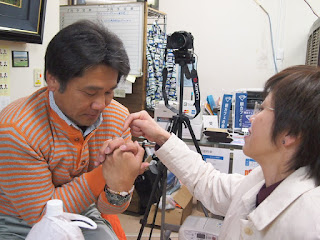Teacher : Macci
Participants: Shizu, Nobuko, Hiro, Namiki, Sam, Mocchan.
Special guest: Sherman
Today's topic is let's try listening English.
本日はリスニングのレッスン。
マチ先生がNHKのラジオ英会話から面白いスキットを準備してくれました。まずは聞いてみましょう。
------Start
A: Are you up for a challenge?
B: Yeah.
A: Let's try zero waste living for one (a) day.
B: OKey,that'll be fun.
C: How about switching paper towel to reusable rags.
B: I'll take a lunchbox instead of a brown paper bag.
A: I'll take a shopping bag to supermarket.
B: You will, Daddy?
A: Yes, thereis (there is) always first time.
C: Ah,that's the sprit. (Energy)
------- End
これは、お父さんと子供の会話です。
あっと言う間に終わった会話の中に、日本人は特に聞き分けしづらいと言われているエル"L"とアール"R"があったり、直訳しただけでは伝わりにくい英語表現を、イメージを膨らませて日本人の感性でも自然な会話だと思えるように理解して聞き取れるのか、がポイントでした。
*** 会話の説明です。 ****
[ Are you up for a challenge? ]
be up for ~ = 〜を受けてくれますか?
ex) Are you up for Ramen ?
ex) Are you up for English lesson?
[ That'll be fun. ] 面白そう
that will be fun が正式表現ですが、会話では、短縮された表現が使われています。
[ Let's try zero waste living for one (a) day. ]
無駄のない生活を一日してみよう
zero waste = zero garbage にも置き換えられます。
[ I'll take a lunchbox instead of brown paper bags. ]
紙バッグを弁当箱に替えてもっていこう。
* brown paper bags
= Westernの人々にとっては、お昼用に食べ物が入った使い捨ての紙袋 = お弁当箱の事を指すみたいです。
[ Switching paper towel to reusable rags. ]
ペーパータオルをボロ布に替えること。
* reusable rags(発音は、らぁぁぁぐす) = 再利用できるボロギレ
単語の冒頭に"re"が付くと、繰り替えしを意味する表現になります。
replay, recycling 等
[ I'll take a shopping bag to supermarket. ]
スーパーに買い物袋を持っていきます。
この場合のshopping bagは、スーパーに持っていくエコバッグの事ですね。
* Daddy = dad = papa = father お父さん
左の方がより幼い表現のようです
日本人も、子供のころはお父さん、で、だんだん親父、と、呼称が変わるような物です。
[ You will, Daddy? ]
スキットの中では、"will"が強調されてました。
パパ、本当に!? と言う意味を強調する為に使われた表現方法のようです。
こんなに驚かれるなんて、お父さんたら、きっとエコバッグを勧められても、いつも拒否してたんでしょうね。
[ Yes, thereis (there is) always a first time. ]
本当はゼア イズ、ですが、発音としてはくっ付けて『ゼア(イ)ズ』
ここは、何にでも始まりがあるよ。っという意味になります。つまり『やってみる』ってニュアンスですかね。
[ That's sprit. (Energy) ] そうこなくっちゃ
= That's the sprit you want.
ここでも、口語的表現になってました。
[ Are you up for a challenge? ]
チャレンジを受けてみるかい?
これは提案する表現です。
* be up for ...(…に乗り気である)を使い、この場合「あるチャレンジを受けますか?」と相手に尋ねています。
チャレンジの内容を説明してから「このチャレンジを受けますか?」と訊くなら、限定する冠詞の "the" を使い "Are you up
for the challenge?" と言います。
急に聞かれも、何だかわからないまま "yes" とは答えにくいですよね。そんな時には、
[ It depends. ] = 状況によるよ と答えても良いでしょう。
正式には
[ It depends (on the situation.) ] ですが、日常会話では、カッコの文章は省かれている事が多いです。
[ Depend on you ] あなた次第です
私達の感覚なら「ケースバイケースだね」のようなニュアンスです。
*** 今日の単語 ***
* waste...[ 名詞 ] 浪費、廃棄物
ex) It's (a) waste of time. それは時間の浪費だ。
ex) medical waste... 医療廃棄物
* waste...[ 動詞 ] 金・時間を浪費する。
ex) waste money [time]...金 [時間]を浪費する
* instead of ~ ...~の代わりに
* lazy.... 怠惰な、だらだらしている
ex) a lazy person... 怠け者
* depend... ゆだねる、当てにする
*****
レッスンのあとは、リラックスして楽しめるゲームを用意してくれました。
Next time is 25th April . See you!!





















